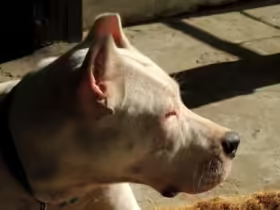Separation anxiety is a common issue among dogs, manifesting as distress and behavioral problems when they are left alone. This condition can cause significant stress for both dogs and their owners, impacting the overall well-being of the household. Understanding how to manage and alleviate separation anxiety can lead to a happier, more harmonious home environment. This comprehensive guide offers practical tips and expert advice on handling dog separation anxiety effectively.
1. Understanding Separation Anxiety
1.1. What is Separation Anxiety?
- Definition: Separation anxiety occurs when a dog becomes excessively distressed when separated from their owner or primary caregiver. It is a behavioral issue that can result in various problems, including destructive behavior, excessive barking, and house soiling.
- Symptoms: Common symptoms include pacing, whining, barking, chewing, digging, and attempts to escape. In severe cases, dogs may experience vomiting or diarrhea.
1.2. Causes of Separation Anxiety
- Change in Routine: Significant changes in a dog’s routine, such as a move to a new home or changes in the owner’s work schedule, can trigger separation anxiety.
- Past Trauma: Dogs with a history of abandonment, abuse, or frequent rehoming are at higher risk for developing separation anxiety.
- Lack of Socialization: Dogs that are not accustomed to being alone or have limited exposure to alone time may develop anxiety when left by themselves.
2. Preventive Measures
2.1. Gradual Desensitization
- Short Absences: Start by leaving your dog alone for short periods and gradually increase the duration. This helps your dog get used to being alone and reduces anxiety over time.
- Positive Reinforcement: Reward your dog with treats and praise when they remain calm during short absences. This helps create a positive association with being alone.
2.2. Create a Safe Space
- Comfortable Area: Designate a specific area or crate as a safe space for your dog. Ensure it is comfortable and filled with their favorite toys, bedding, and items that provide security.
- Familiar Objects: Leave behind items with your scent, such as a worn shirt or a blanket, to provide comfort and reassurance while you’re away.
2.3. Establish a Routine
- Consistent Schedule: Maintain a consistent daily routine for feeding, exercise, and playtime. A predictable schedule helps your dog feel secure and reduces anxiety.
- Pre-Departure Routine: Develop a departure routine that includes activities such as a walk or play session. This can help your dog associate your leaving with positive experiences.
3. Behavioral Strategies
3.1. Training Exercises
- Command Training: Teach your dog basic commands such as “stay” and “sit.” This can help reinforce positive behavior and provide structure during periods of separation.
- Interactive Toys: Use puzzle toys and treat-dispensing toys to keep your dog engaged and mentally stimulated while you are away.
3.2. Counter-Conditioning
- Change Associations: Gradually change your dog’s association with being alone by pairing it with positive experiences. For example, give your dog a special treat or toy that they only receive during alone time.
- Desensitize Triggers: Identify and desensitize specific triggers that cause anxiety, such as the sound of your car keys or the act of picking up your bag. Practice these actions without leaving to help reduce anxiety.
4. Professional Help
4.1. Consult a Veterinarian
- Medical Evaluation: Consult a veterinarian to rule out any underlying medical issues that may be contributing to your dog’s anxiety. In some cases, medical conditions can exacerbate behavioral problems.
- Medication: For severe cases of separation anxiety, your veterinarian may recommend medication as part of a comprehensive treatment plan. Medication should be used in conjunction with behavioral modification techniques.
4.2. Work with a Professional Trainer
- Behavioral Training: A professional dog trainer or behaviorist can provide personalized guidance and develop a tailored behavior modification plan to address separation anxiety.
- Group Classes: Consider enrolling in group training classes to provide your dog with additional socialization opportunities and reinforce positive behaviors.
5. Environmental Adjustments
5.1. Reduce Stimulation
- Calm Environment: Create a calm environment for your dog by reducing noise and avoiding distractions during departure and arrival times. This helps minimize anxiety and creates a more relaxed atmosphere.
- Comforting Sounds: Use soothing music or white noise machines to help mask outside noises that may trigger anxiety or contribute to feelings of isolation.
5.2. Exercise and Enrichment
- Physical Exercise: Ensure your dog receives adequate physical exercise through daily walks, play sessions, and interactive activities. Exercise helps reduce excess energy and promotes relaxation.
- Mental Stimulation: Provide mental enrichment through interactive toys, training exercises, and puzzle games. Mental stimulation can help keep your dog occupied and reduce boredom-related anxiety.
6. Managing Transitions
6.1. Gradual Departures and Arrivals
- Avoid Overexcitement: Keep departures and arrivals low-key to avoid creating an emotional peak. Over-excited greetings or farewells can increase anxiety and anticipation.
- Practice Departures: Practice short, casual departures and arrivals to help your dog become accustomed to the routine and reduce anxiety associated with these events.
6.2. Consistent Interaction
- Quality Time: Spend quality time with your dog to strengthen your bond and build trust. Regular playtime, training sessions, and affection help create a positive and supportive relationship.
- Reassurance: Provide reassurance and comfort when you are home, but avoid reinforcing anxious behavior. Focus on calm, positive interactions to build your dog’s confidence and security.
7. Monitoring Progress
7.1. Track Behavior
- Behavioral Changes: Monitor your dog’s behavior and note any changes or improvements in their anxiety levels. Keeping a journal can help track progress and identify patterns.
- Adjust Strategies: Adjust your strategies and techniques based on your observations and your dog’s response. Flexibility and consistency are key to managing separation anxiety effectively.
7.2. Celebrate Successes
- Positive Reinforcement: Celebrate and reward successes and improvements, no matter how small. Positive reinforcement encourages continued progress and reinforces desired behaviors.
- Patience and Persistence: Be patient and persistent in your efforts. Managing separation anxiety is a gradual process, and consistent effort will lead to positive results over time.
Conclusion
Handling dog separation anxiety requires a combination of understanding, patience, and proactive strategies. By recognizing the causes of separation anxiety and implementing effective behavioral techniques, environmental adjustments, and professional support, you can help your dog feel more secure and comfortable when left alone.
Creating a stress-free home environment for both you and your dog involves consistent effort and a compassionate approach. With the right strategies and support, you can alleviate separation anxiety and foster a happier, more confident canine companion. Embrace the journey of managing separation anxiety with dedication and care, and enjoy the benefits of a harmonious and loving relationship with your dog.











Leave a Reply